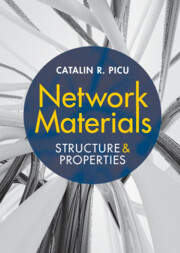Book contents
- Network Materials
- Network Materials
- Copyright page
- Contents
- Preface
- 1 Introduction
- 2 Fibers and Fiber Bundles
- 3 Fiber Interactions
- 4 Network Structure and Geometric Parameters
- 5 Affine Deformation
- 6 Mechanical Behavior and Relation to Structural Parameters
- 7 Constitutive Formulations for Network Materials
- 8 Strength and Toughness of Network Materials
- 9 Time Dependent Behavior
- 10 Networks with Fiber Surface Interactions
- 11 Composite Networks
- Index
- References
2 - Fibers and Fiber Bundles
Published online by Cambridge University Press: 15 September 2022
- Network Materials
- Network Materials
- Copyright page
- Contents
- Preface
- 1 Introduction
- 2 Fibers and Fiber Bundles
- 3 Fiber Interactions
- 4 Network Structure and Geometric Parameters
- 5 Affine Deformation
- 6 Mechanical Behavior and Relation to Structural Parameters
- 7 Constitutive Formulations for Network Materials
- 8 Strength and Toughness of Network Materials
- 9 Time Dependent Behavior
- 10 Networks with Fiber Surface Interactions
- 11 Composite Networks
- Index
- References
Summary
Various types of fibers encountered in Network materials are presented and classified in this chapter. Their mechanical behavior is of primary concern here. The first section describes the structure and mechanical behavior of cellulose fibers, polymeric fibers used in nonwovens, and collagen fibers forming connective tissue. The remainder of the chapter is divided into three parts presenting the mechanical behavior of athermal fibers, thermal filaments, and of fiber bundles. The linear, nonlinear, and rupture characteristics of athermal fibers are presented. Thermal filaments, which form molecular networks such as elastomers and gels, are described by the Gaussian, Langevin, and self-avoiding random walk models. Models describing the mechanics of semiflexible filaments are presented. The section on the mechanics of fiber bundles presents a number of results relevant for bundles of continuous and discontinuous (staple) fibers, including the effect of bundle twisting and of packing on the axial stiffness and strength of the bundle. These results apply to many networks of practical importance which are composed from fiber bundles.
Keywords
- Type
- Chapter
- Information
- Network MaterialsStructure and Properties, pp. 13 - 73Publisher: Cambridge University PressPrint publication year: 2022

